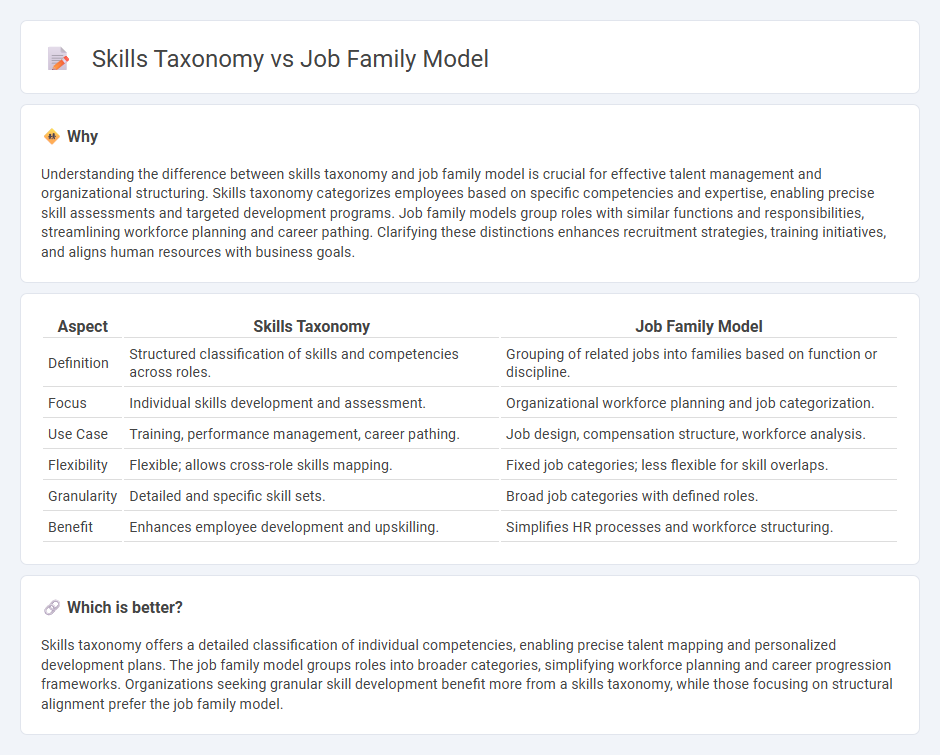
Skills taxonomy organizes employee abilities and competencies into a structured framework that enhances talent development and targeted training within Human Resources. The job family model groups similar roles based on shared responsibilities and qualifications, improving workforce planning and career progression paths. Explore how these models transform talent management strategies for optimized organizational performance.
Why it is important
Understanding the difference between skills taxonomy and job family model is crucial for effective talent management and organizational structuring. Skills taxonomy categorizes employees based on specific competencies and expertise, enabling precise skill assessments and targeted development programs. Job family models group roles with similar functions and responsibilities, streamlining workforce planning and career pathing. Clarifying these distinctions enhances recruitment strategies, training initiatives, and aligns human resources with business goals.
Comparison Table
| Aspect | Skills Taxonomy | Job Family Model |
|---|---|---|
| Definition | Structured classification of skills and competencies across roles. | Grouping of related jobs into families based on function or discipline. |
| Focus | Individual skills development and assessment. | Organizational workforce planning and job categorization. |
| Use Case | Training, performance management, career pathing. | Job design, compensation structure, workforce analysis. |
| Flexibility | Flexible; allows cross-role skills mapping. | Fixed job categories; less flexible for skill overlaps. |
| Granularity | Detailed and specific skill sets. | Broad job categories with defined roles. |
| Benefit | Enhances employee development and upskilling. | Simplifies HR processes and workforce structuring. |
Which is better?
Skills taxonomy offers a detailed classification of individual competencies, enabling precise talent mapping and personalized development plans. The job family model groups roles into broader categories, simplifying workforce planning and career progression frameworks. Organizations seeking granular skill development benefit more from a skills taxonomy, while those focusing on structural alignment prefer the job family model.
Connection
Skills taxonomy and job family models are interconnected frameworks that enhance human resources management by categorizing and aligning employee competencies with organizational roles. Skills taxonomy provides a structured inventory of skills and proficiencies necessary across various jobs, while the job family model groups related roles based on shared functions and skill requirements. This integration facilitates targeted talent development, precise job matching, and effective workforce planning within HR operations.
Key Terms
**Job Family Model:**
The Job Family Model organizes roles into groups based on shared functions, responsibilities, and career paths, enabling clearer workforce planning and talent development. It emphasizes categorizing jobs by similar competencies and progression levels within specific domains such as finance, engineering, or marketing. Discover how implementing a Job Family Model can streamline HR processes and enhance organizational efficiency.
Job Classification
The job family model organizes roles into groups based on similar functions, streamlining job classification through clear career paths and hierarchical structures. Skills taxonomy categorizes skills and competencies across various roles, emphasizing specific abilities rather than job titles. Explore deeper insights into job classification strategies by understanding the distinct benefits of these frameworks.
Career Pathways
The Job Family Model organizes roles into broad categories based on function, streamlining career pathways by clearly defining job clusters and progression opportunities within an organization. Skills Taxonomy, on the other hand, categorizes and maps specific competencies required for roles, enabling targeted skill development and personalized career growth. Explore how integrating both frameworks can enhance career pathway planning and talent management strategies.
Source and External Links
What Is a Job Family? | AIHR - HR Glossary - A job family is a classification of related job positions within an organization that share similar skills, responsibilities, and career paths, aiding in workforce management, compensation, and career development.
Job Family Model | A Foundation for Integrated HR Management - The job family model organizes work along logical career paths and serves as the foundation for HR processes such as compensation, performance management, and promotions by mapping jobs to standardized competency and skill frameworks.
Job Family Frameworks for effective career path mapping - Job family frameworks group related jobs by similar skill sets and work nature, establishing a clear structure for career progression and simplifying organizational job data management.
 dowidth.com
dowidth.com